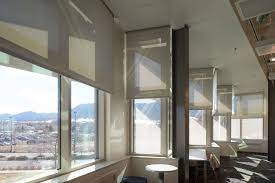A sustainable method of building and designing that puts an emphasis on occupant well-being, environmental responsibility, and resource efficiency is called “green building design.” Using energy-efficient practices and technologies is one of the main elements of green building design. A major part of accomplishing these goals is played by automatic shades, sometimes referred to as motorized or smart shades. We’ll look at how automatic shades support green building design in this blog and help make spaces that are comfortable, energy-efficient, and friendly to the environment.
- The Efficiency of Energy
An essential component of green building design is energy efficiency, and automated shades are a useful tool for reaching this objective. The position of these shades can be programmed to change according to the weather, season, and time of day. By optimizing solar heat gain and natural daylighting, this dynamic control lowers the demand for artificial lighting and HVAC systems.
Automatic shades help maintain a comfortable indoor temperature without overly relying on HVAC systems by automatically drawing down during hot summer afternoons to block out excess sunlight and raising them during winter mornings to harness passive solar heat. Lower energy use and lower utility costs are the outcomes of this.
- Harvesting Daylight
A tactic called daylight harvesting makes the most of natural light when it comes to lighting interior areas. Given their ability to precisely control the amount of sunlight entering a room, automatic shades are a crucial part of daylight harvesting systems. Automatic shades complement smart lighting systems to provide precisely the right amount of light for tasks and occupant comfort.
Automated shades save a lot of energy because they enable daylight harvesting, which lessens the need for artificial lighting during the day. This is good for the environment and improves indoor lighting quality, which raises well-being and productivity.
- Reduction of Solar Heat Gain
Particularly in the summer, excessive solar heat gain can cause buildings to overheat. Conventional blinds or window coverings might not provide enough control over this problem, which would raise the cost of air conditioning. Sun sensors installed in automatic shades allow them to sense solar heat gain and change their operation automatically to either diffuse or block sunlight.
Automatic shades assist in preserving a comfortable interior temperature without using air conditioning exclusively by effectively controlling solar heat gain. In line with the concepts of green building design, this lowers energy consumption and the corresponding greenhouse gas emissions.
- Convergence with Building Management Systems
Automated shades can be easily incorporated into smart home automation systems or building management systems (BMS). Centralized control and coordination of multiple building systems, such as lighting, shading, heating, and cooling, are made possible by this degree of integration.
BMS interfaces or mobile apps can be used by building occupants and facility managers to create personalized schedules for shade operation that are in line with occupancy patterns and energy efficiency objectives. This degree of automation makes sure that shades are positioned as efficiently as possible throughout the day, which improves occupant comfort and energy efficiency.
- Comfort and Productivity of Occupants
A major focus of green building design is the comfort and well-being of the occupants. Automated shades help achieve these goals by creating a cozier and more enjoyable interior atmosphere. They can be adjusted to lessen glare on TVs and computers, which will relieve discomfort and eye strain.
Additionally, by letting residents take in views while still controlling sunlight and privacy, automated shades can foster a sense of connection with the outside world. It has been demonstrated that spending time in nature increases wellbeing, lowers stress levels, and boosts productivity.
- Less Maintenance and Extended Life
Automatic shades are made to last a long time with little upkeep. In contrast to manual adjustments and frequent cleaning that may be necessary for traditional blinds or curtains, automatic shades are effortlessly operated and maintained. Because the automated mechanisms are long-lasting, fewer maintenance or replacements will be required.
Because they last a long time, automatic shades are a sustainable and economical option that will improve occupant comfort and energy efficiency for the duration of the building.
- Adaptable Design Choices
With so many different styles, materials, and finishes available for automatic shades, architects and designers can choose options that blend in with the building’s overall architectural style. Automatic shades may be tailored to perfectly complement the interior decor of any building, whether it’s a residential house, business office, or educational institution.
Green building design principles prioritize both form and function, and their flexible design options guarantee that they not only fulfill a functional purpose but also improve the overall aesthetics of the space.
- Diminution of Noise
Automated shades not only provide comfort and energy efficiency, but they can also help reduce noise in buildings. They can aid in reducing outside noise from sources like traffic, construction, or other sources by automatically lowering or raising the shades, making the interior quieter and more serene.
Reducing noise pollution supports the holistic philosophy of green building design by improving health and well-being in addition to improving occupant comfort.
In summary, automatic shades are essential for green building design because they encourage environmental responsibility, occupant comfort, and energy efficiency. They are an invaluable addition to sustainable architecture and construction because of their capacity to maximize natural daylighting, minimize solar heat gain, integrate with building management systems, and improve general well-being. Learn more about Charleston Window Treatments and how automatic shades are positioned to become a crucial component of green building design, resulting in more energy-efficient, comfortable, and environmentally conscious interior spaces, as the demand for sustainable and eco-friendly building solutions grows.



